Touring the Cappadocia region
At first the tours my hotel manager suggests seem pricey, but after consulting my guidebook, I agree they're the easiest way to get around. There is an "Off-the-beaten track" tour, slightly cheaper and very appealing, but it doesn't include Ihlara. I choose the classic Ihlara Valley tour instead, which includes a hike through the gorge, a visit to the underground city Kaymakli, a caravanserai, a rock-cut monastery, and Pigeon Valley.
The tour is supposed to start at 9am. We actually depart from Shoestring at 9:30 and then go pick up more people at a different hotel. Working on Turkish time? Blame actually seems to rest on travelers who couldn't get out of bed. There isn't much sunlight in those cave rooms.
Our group is far too large for only one guide, although he is very good and does his best. Switching back and forth between our two vans, he describes the history of Cappadocia, from Hittite Kingdom to provinces of first the Persian Empire then the Roman Empire. During the Byzantine period following the breakup of the Roman Empire, religious debates broke out over the region among sects of Christians, with some fleeing to Cappadocia to worship more comfortably. From the Seljuk period forward, when Turks spread throughout Anatolia, Cappadocian religions were treated with tolerance
All these years of invasions and wars led to the use of underground cities as hiding places. The first stop on our tour is Kaymakli. There are adorable children playing around the area and headscarved women selling trinkets. The children practice their "hellos" cheerfully.
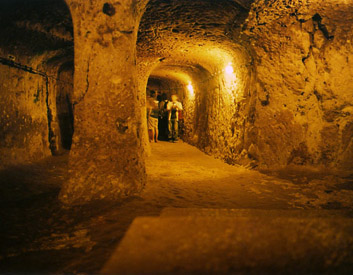 | 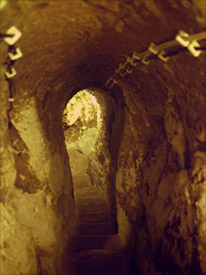 |
The city is quite extensive, featuring wells, wine-presses, storage and livestock pens. We peer at ancient stone kitchens and wonder aloud how the refugees went to the toilet. The city contains enough basic necessities, including chapels, for people to live comfortably for months until it was safe to emerge.
It's believed 15,000 people lived here at one time. Because of Kaymakli's popularity, I often have to back up out of a narrow stairwell or press against the walls or strain to hear our tour guide; it's hard to imagine being trapped underground with a large village, nervously waiting news of the battles above. There isn't quite as much time to lose myself as I'd like—but the size of my group makes me doubt the wisdom of that idea anyway.
We pile back into the van for Ihlara Valley. The van is comfortable but stuffy ; the driver refuses to let us open any windows, insisting the A/C is on. One of the many Japanese tourists falls asleep drooling on my shoulder.
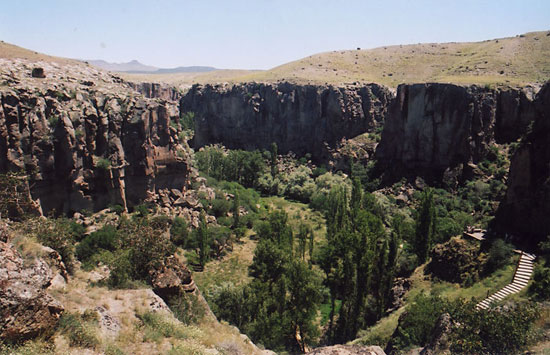 Ihlara is a beautiful, dramatic gorge cut by a stream through the lush greenery and the peaks of Cappadocia. For those who cannot or choose not to do a strenuous hike, the best place to start walking is at the visitor's center at the top of the gorge. The tour includes a pick-up near the lunch spot, which I'm thankful for as we descend hundreds of steps into the valley and pass robed Turkish women slowly panting their way up.
Ihlara is a beautiful, dramatic gorge cut by a stream through the lush greenery and the peaks of Cappadocia. For those who cannot or choose not to do a strenuous hike, the best place to start walking is at the visitor's center at the top of the gorge. The tour includes a pick-up near the lunch spot, which I'm thankful for as we descend hundreds of steps into the valley and pass robed Turkish women slowly panting their way up.
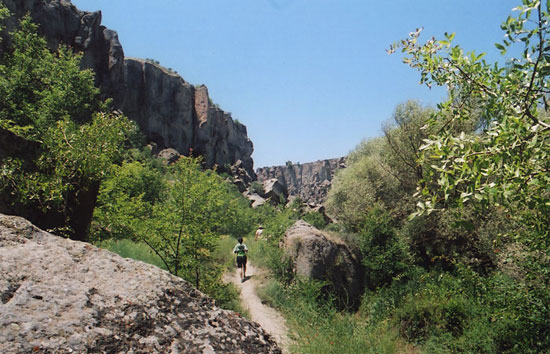 Dove-cotes, sets of half-moon indentations cut in the rock, are a sign of human life seen everywhere in the gorge. They served for collecting bird droppings as fertilizer. Carved doorways and windows of homes and churches are spotted throughout the hike.
Dove-cotes, sets of half-moon indentations cut in the rock, are a sign of human life seen everywhere in the gorge. They served for collecting bird droppings as fertilizer. Carved doorways and windows of homes and churches are spotted throughout the hike.
Unfortunately the size of the group keeps the beautiful walk from being as peaceful as it could be, as the Korean tourists stop every 2 minutes to pose, first one in front of a tree, then two in front of the tree, then the whole group giggling in front of the tree. They pout, fling their hair, throw peace signs for the photos and it's all very amusing but they're in my damn way.
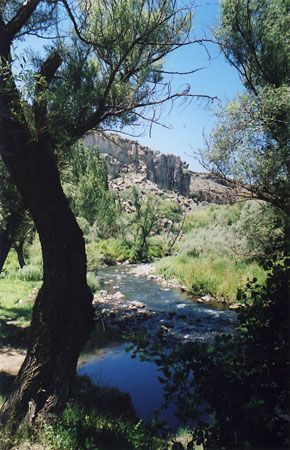 The tour does not allow for slow meandering. There are supposedly cave churches everywhere in this valley, but we are only shown the one with the best-preserved frescoes. Then we are told to follow the path until we reach the restaurant, about 3KM away. Our orders are taken soon after we arrive, so the only way I can explore more is to eat in about 15 minutes, which is impossible.
The tour does not allow for slow meandering. There are supposedly cave churches everywhere in this valley, but we are only shown the one with the best-preserved frescoes. Then we are told to follow the path until we reach the restaurant, about 3KM away. Our orders are taken soon after we arrive, so the only way I can explore more is to eat in about 15 minutes, which is impossible.
Lunch is great though, especially the excellent flatbread and pleasant location along the stream.
Next we visit Selime, a rock monastery exceptional for its size and details. Another popular site with foreigners and locals alike, the walk up to the monastery from the road is a bit steep and very slippery, which causes some traffic jams. It's lovely at the top, with gorgeous views of the moon-like peaks below.
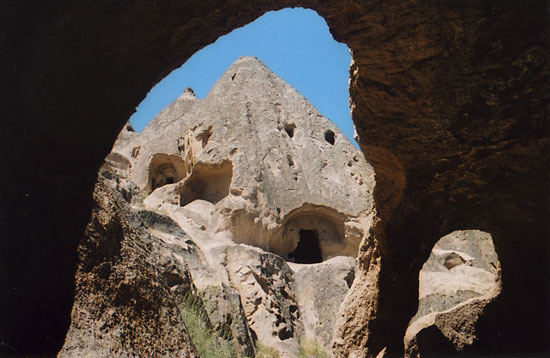 The monastery is like an otherworldly playground, with many chambers and windows and alternate entrances and faded frescoes. My favorite part is the large central tuft that is possibly the monks' quarters; I climb up unsteadily and marvel at the scenery.
The monastery is like an otherworldly playground, with many chambers and windows and alternate entrances and faded frescoes. My favorite part is the large central tuft that is possibly the monks' quarters; I climb up unsteadily and marvel at the scenery.
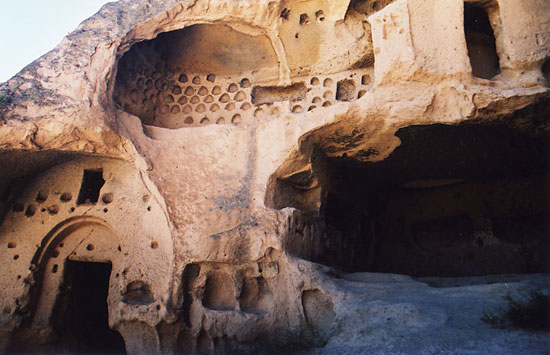 The tour goes downhill from here, although hardly unpleasant. We are taken to a village that produces absolutely stunning pottery. Then we are encouraged to buy some. We visit a factory that produces extraordinary jewelry. Then we are encouraged to buy some. We visit a caravanserai (inn for traders), which has been thoughtfully filled with stalls of merchandise. Just like the days of yore!
The tour goes downhill from here, although hardly unpleasant. We are taken to a village that produces absolutely stunning pottery. Then we are encouraged to buy some. We visit a factory that produces extraordinary jewelry. Then we are encouraged to buy some. We visit a caravanserai (inn for traders), which has been thoughtfully filled with stalls of merchandise. Just like the days of yore!
The final stop is Pigeon Valley. I'm tired at this point, and wondering if I should have jumped ship when we passed through Goreme again, as many of my fellow tourists did. But stupidly, I was determined to get my money's worth so I stuck it out through the sales pitches. Pigeon Valley is famous for phallic rock formations, but we aren't given time to go hiking. It's basically just a photo-op; quickly bored, I settle in for some maras dondurma. The stretchy ice cream is the best part of the afternoon.
I really like my funny and friendly tour guide, who is extremely knowledgeable and patient even when it's obvious he's annoyed by the Korean tourists. At first I feel racially obligated to jump to their defense, but I'm soon irritated as well. They are such a large group that they seem to believe the tour caters to them, and often wander off while we are waiting to leave. I think we could have had time to hike in Pigeon Valley if they hadn't dawdled elsewhere. My guide is in a hurry to return by 6PM as scheduled because the driver has a family waiting for him at home. The guide turns out to be good friends with the staff of Shoestring and meets up with his girlfriend there for some drinks after the tour.
It's probably better that the tour lumps the sights together this way, so if I hadn't been so concerned about the price I paid I could have left after Selime and not really missed out. Next time I'll definitely go for the "off-the-beaten track" tour and ask questions about the number of sales stops in advance.
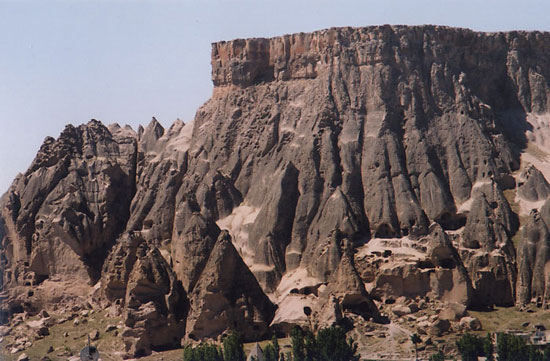
The Ihlara Valley tour is operated by Nomad Tours, which has an office in the village. If you are not staying with Shoestring or the other hotels associated with Nomad, you can book directly through the office. The classic tour costs 50YTL, including entrance fees and lunch in the gorge, and lasts from 9AM-6PM. Some operators may skimp on providing a truly informed, English-speaking guide, and some don't even complete the tour as promised. Nomad Tours is highly recommended.